Lost and forgotten
I would not be surprised if many people think that the first private rocket into space was launched by Ilon Musk with his company SpaceX. This is not so - Falcon 1 was the first liquid rocket developed with private funds and reaching orbit. The first rocket, developed with private funds and launched into orbit, was the solid Pegasus back in 1990. And the first rocket, developed with private funds and reaching space, was Conestoga I in 1982. On the side of the road of private space are fragments of companies that once lost and were forgotten. Sometimes they have an interesting fate - for example, test benches for engines of the closed Beal Aerospace in MacGregor bought SpaceX and use them for the same purpose. The history of failures of ceased private space companies is instructive and worth remembering.
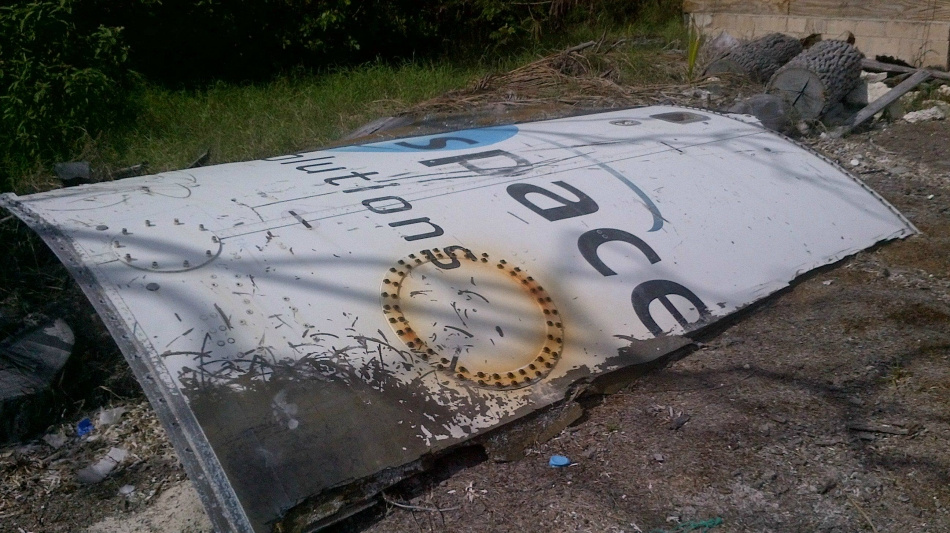
The place of the “icon of private rocket science” could have been occupied forty years ago by Lutz Kaiser. He had everything he needed for this - Zenger's student, Kaiser attracted the legendary von Braun and Kurt Debuss as consultants. The money was provided by a consortium of six hundred investors. And the design of the rocket was revolutionary and promised a serious reduction in the cost of putting a kilogram into orbit.
In 1975, the company OTRAG (Orbital Transport and Missiles) was founded. The rocket of the same name was supposed to consist of standardized simple, reliable CRPU blocks, which would be made on an automated conveyor by the hundreds and thousands and cost a penny.
')

But all the glittering dreams undermined politics. The territory of Zaire (now the territory of the Democratic Republic of the Congo) chosen for the cosmodrome caused fears in the proliferation of dual-purpose missile technologies, and existing rocket companies did not need competitors. As a result, under pressure from the USSR, France and the USA, production in Germany and the cosmodrome in Zaire were closed. Kaiser moved equipment to Libya and conducted there 14 successful tests. The sources disagree on what happened next, but the Kaiser equipment in Libya captured Gaddafi and unsuccessfully tried to make combat missiles, and the last OTRAG rocket launched from Esrange (Kiruna) in Sweden on September 19, 1983.
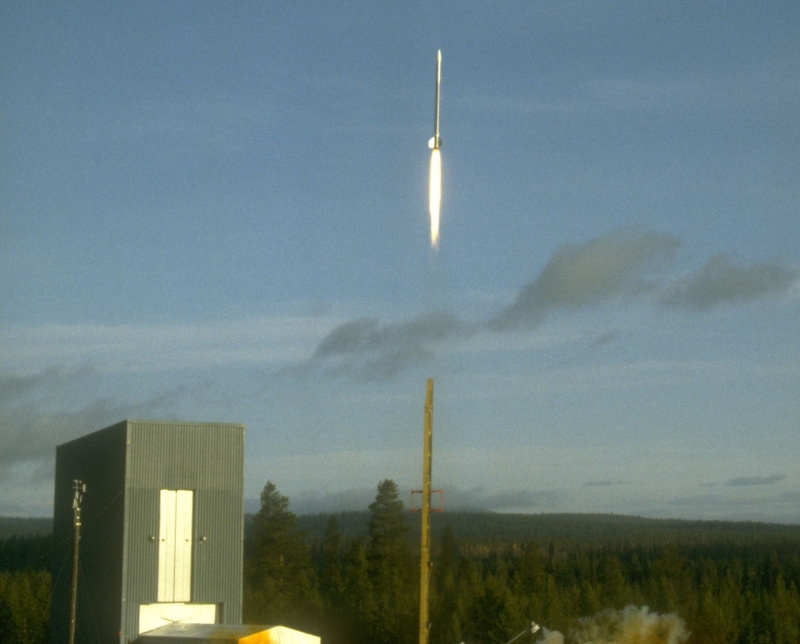
Last start of OTRAG
As a result, Germany joined the Ariane launch vehicle project, and Lutz Kaiser lived for a long time in Tripoli (Libya), working on "green energy" - solar towers with a rising flow . In 2008, he began working at Interorbital Systems , which is now developing a modular Neptune rocket, built on the same principle as OTRAG, and is engaged in nanosatellites. The CPM module (a descendant of the CPRU) successfully started in 2014, and now Interorbital is making the second version. Alas, she can only dream of $ 200 million collected from investors on the OTRAG in the 70s (in today's dollars it is 500-900 million).
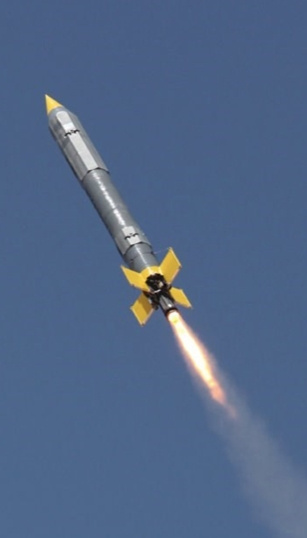
Start CPM in 2014
The next attempt at private space exploration is associated with the name of Gary Hudson and Space Services Inc. of America (SSIA). After spending a year and $ 1.2 million, Hudson built the Percheron rocket. Here, too, the idea was simplicity — instead of a complicated turbopump, pressure was used to pressurize the pressurized gas. In August 1981, a rocket was brought to a ranch in Texas and tried to launch.

Installation of the rocket on the launch pad
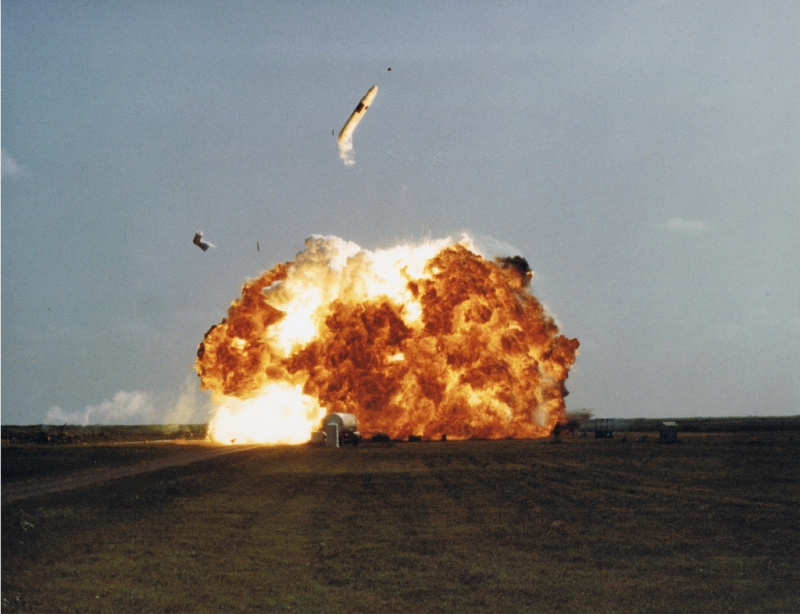
And a bad start
After the explosion at the start of the Percheron, the collaboration of the SSIA, which provided the funding, and Hudson, who made the rockets, ended. Hudson wanted to continue to engage in liquid rockets, and the SSIA decided to switch to solid fuel.
The SSIA hired Dick Slayton, an astronaut from the legendary first seven, and came up with the idea of assembling a rocket from the second stages of a combat intercontinental rocket Minuteman. In September 1982, the Conestoga I from one second stage successfully launched and delivered to a height of 313 km a 500 kg payload mockup, of which 40 kg was water.

Conestoga I at the start
The rocket was actually geophysical and could not put the payload into orbit, but, nevertheless, it was the first private rocket to reach space. To launch the satellites, a heavier rocket was needed, and the SSIA came up with a simple to the genius method: solid-fuel side blocks from the same second steps of the Minuteman were installed around the central and switched on at different heights.
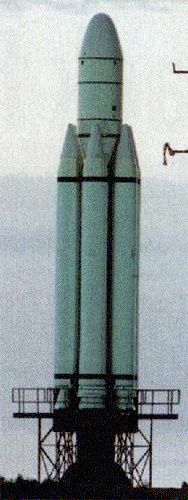
Blocks with wide nozzles included at high altitude.
Alas, the attempt to create a rocket in the best traditions of the Kerbal Space Program, before the release of which was another thirty years, ended with an impressive destruction of the ligament on the 46th second of the flight, just like in KSP.

The first launch of Conestoga 1620 October 23, 1995 was the last - in the early 90s SSIA left a large investor, and there was no money left for a new attempt. Today, the SSIA has dropped to the point where it sells the names of stars (the International Astronomical Union reminds us that it is impossible to buy the name of a star) and launches anything, from a souvenir to the ashes of the deceased, into space by passing loads on foreign rockets.
Gary Hudson, on the other hand, was chasing the blue bird of accessible space by another road. He was captured by the idea of an SSTO apparatus, which can reach the orbit in one step and be used many times. And his brain gave birth to a completely insane construction - a helicopter with a jet-driven blades had to go into space. In this case, the blades solved several problems at once. The main thing was to create enormous pressure with centrifugal force so that the rocket engines at the ends of the blades were effective. In fact, the blades would work like a turbo pump of a conventional engine. In addition, they would create a lift force during takeoff, work as a brake when descending in the atmosphere, and allow for a controlled, precise landing. However, by 1999 they decided to take off after all on a conventional rocket engine, and to use the blades during landing. Hudson managed to raise $ 30 million and build a technology demonstrator who looked like pepelatz from the movie “Kin-dza-dza” and could fly like a helicopter. On it was the main rotor, taken from the crashed helicopter S-58, which spun the engines for hydrogen peroxide, similar to those used on the spacecraft during landing.

Alas, for the work it was necessary at least another $ 120 million, which Hudson had already failed to collect. The company Rotary Rocket filed for bankruptcy in 2001, and pepelats stands as a monument at the airport in the Mojave Desert.
In the zero years, Hudson worked in various near-cosmic firms, and now is the CEO of the non-commercial Space Studies Institute, who is trying to think of ways to make space more accessible.
A successful investor, the founder of his own bank, a mathematician, who proposed a generalization of Fermat's theorem, which has not yet been disproved, it seemed that Andrew Beal could take any job. And at the end of the 90s he was interested in space. In 1997, he founded the company Beal Aerospace, which already two years later worked 200 people. The BA-2 rocket, which was developed by the company, had to use high technology to maximally simplify the design and reduce the cost of a kilogram into orbit. The displacing feed replaced the expensive and complex turbopumps, the injection of fluid into the engine - a complex system of his turn to control the flight. Even the fuel pair was chosen as accessible as possible - kerosene and concentrated hydrogen peroxide. The absence of cryogenic components simplified both the design and the starting equipment. Engine cooling components replaced by ablative - a thick wall slowly evaporated, taking the thermal energy with them. The walls of the tanks should have been composite, which would make them light and strong. Even the issues of reuse steps were worked out.

Third stage engine, maximum simplicity visible to the naked eye
The BA-2 rocket was to consist of three stages, each of which would have had one engine. With an initial mass of 970 tons, it could put 17 tons of payload into orbit. Using one engine per stage meant that the engine had fantastic power at the first stage. Indeed, the BA-3200 engine under development should have a thrust of 1,400 tons, which is comparable to the Space Shuttle side accelerator.
On March 4, 2000, Beal Aerospace successfully tested the second-stage engine BA-810 with a thrust of 367 tons, which is comparable to that of the RD-180.
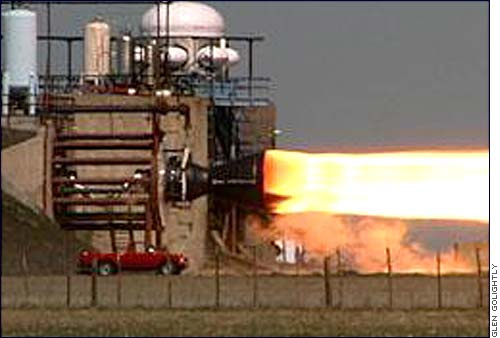
On the car in the photo is clearly visible the size of the engine
It would seem that the success of Beal Aerospace is near. But in 2000, NASA announced the Space Launch Initiative program, which provided funding for, in fact, competing projects. And Andrew Beale decided that there was no point in competing in such conditions. On October 23, 2000, Beal Aerospace was closed. Let me quote a couple of paragraphs from the farewell letter .
According to the EELV program mentioned in the letter, the Delta IV and Atlas V missiles were developed. It is difficult to say whether Musk read this letter, but he chose the second way - the state contractor and, having become a dragon, gnaws the dragons of the past generation that Beel did not want to fight.
They claim that Bill has invested about $ 200 million in a space company. The businesses created earlier allowed him not to go broke, and in 2001 he started playing poker. In 2004, he won one of the largest amounts in a single game - $ 11.7 million. In 2006, he won $ 13.6 million in three days, and then lost 16.6 in three days. In 2013, the reward for proving or disproving Bil 's hypothesis (generalizing the Fermat theorem) was increased by him to one million dollars, and so far no one has received it. In 2016, he actively supported Trump, donating $ 2 million for his election campaign and another million for the inauguration celebration.
26 companies fought for Ansari X Prize, the condition of which was the launch of a manned spacecraft into space twice within two weeks. Only a few managed to do anything. One company won, but the SpaceShipOne winning apparatus was handed over to the museum, and the winning company still cannot start flights with tourists. But all these failures were not in vain. At the new level of technology, new companies will try to make space more accessible, and someone might be able to do something. The main thing - do not forget about those who walked this road before.

OTRAG
The place of the “icon of private rocket science” could have been occupied forty years ago by Lutz Kaiser. He had everything he needed for this - Zenger's student, Kaiser attracted the legendary von Braun and Kurt Debuss as consultants. The money was provided by a consortium of six hundred investors. And the design of the rocket was revolutionary and promised a serious reduction in the cost of putting a kilogram into orbit.
In 1975, the company OTRAG (Orbital Transport and Missiles) was founded. The rocket of the same name was supposed to consist of standardized simple, reliable CRPU blocks, which would be made on an automated conveyor by the hundreds and thousands and cost a penny.
')

But all the glittering dreams undermined politics. The territory of Zaire (now the territory of the Democratic Republic of the Congo) chosen for the cosmodrome caused fears in the proliferation of dual-purpose missile technologies, and existing rocket companies did not need competitors. As a result, under pressure from the USSR, France and the USA, production in Germany and the cosmodrome in Zaire were closed. Kaiser moved equipment to Libya and conducted there 14 successful tests. The sources disagree on what happened next, but the Kaiser equipment in Libya captured Gaddafi and unsuccessfully tried to make combat missiles, and the last OTRAG rocket launched from Esrange (Kiruna) in Sweden on September 19, 1983.

Last start of OTRAG
As a result, Germany joined the Ariane launch vehicle project, and Lutz Kaiser lived for a long time in Tripoli (Libya), working on "green energy" - solar towers with a rising flow . In 2008, he began working at Interorbital Systems , which is now developing a modular Neptune rocket, built on the same principle as OTRAG, and is engaged in nanosatellites. The CPM module (a descendant of the CPRU) successfully started in 2014, and now Interorbital is making the second version. Alas, she can only dream of $ 200 million collected from investors on the OTRAG in the 70s (in today's dollars it is 500-900 million).

Start CPM in 2014
"Persheron", who gave birth to "Konestoga" and "Roton"
The next attempt at private space exploration is associated with the name of Gary Hudson and Space Services Inc. of America (SSIA). After spending a year and $ 1.2 million, Hudson built the Percheron rocket. Here, too, the idea was simplicity — instead of a complicated turbopump, pressure was used to pressurize the pressurized gas. In August 1981, a rocket was brought to a ranch in Texas and tried to launch.

Installation of the rocket on the launch pad

And a bad start
After the explosion at the start of the Percheron, the collaboration of the SSIA, which provided the funding, and Hudson, who made the rockets, ended. Hudson wanted to continue to engage in liquid rockets, and the SSIA decided to switch to solid fuel.
The SSIA hired Dick Slayton, an astronaut from the legendary first seven, and came up with the idea of assembling a rocket from the second stages of a combat intercontinental rocket Minuteman. In September 1982, the Conestoga I from one second stage successfully launched and delivered to a height of 313 km a 500 kg payload mockup, of which 40 kg was water.

Conestoga I at the start
The rocket was actually geophysical and could not put the payload into orbit, but, nevertheless, it was the first private rocket to reach space. To launch the satellites, a heavier rocket was needed, and the SSIA came up with a simple to the genius method: solid-fuel side blocks from the same second steps of the Minuteman were installed around the central and switched on at different heights.

Blocks with wide nozzles included at high altitude.
Alas, the attempt to create a rocket in the best traditions of the Kerbal Space Program, before the release of which was another thirty years, ended with an impressive destruction of the ligament on the 46th second of the flight, just like in KSP.

The first launch of Conestoga 1620 October 23, 1995 was the last - in the early 90s SSIA left a large investor, and there was no money left for a new attempt. Today, the SSIA has dropped to the point where it sells the names of stars (the International Astronomical Union reminds us that it is impossible to buy the name of a star) and launches anything, from a souvenir to the ashes of the deceased, into space by passing loads on foreign rockets.
Gary Hudson, on the other hand, was chasing the blue bird of accessible space by another road. He was captured by the idea of an SSTO apparatus, which can reach the orbit in one step and be used many times. And his brain gave birth to a completely insane construction - a helicopter with a jet-driven blades had to go into space. In this case, the blades solved several problems at once. The main thing was to create enormous pressure with centrifugal force so that the rocket engines at the ends of the blades were effective. In fact, the blades would work like a turbo pump of a conventional engine. In addition, they would create a lift force during takeoff, work as a brake when descending in the atmosphere, and allow for a controlled, precise landing. However, by 1999 they decided to take off after all on a conventional rocket engine, and to use the blades during landing. Hudson managed to raise $ 30 million and build a technology demonstrator who looked like pepelatz from the movie “Kin-dza-dza” and could fly like a helicopter. On it was the main rotor, taken from the crashed helicopter S-58, which spun the engines for hydrogen peroxide, similar to those used on the spacecraft during landing.

Alas, for the work it was necessary at least another $ 120 million, which Hudson had already failed to collect. The company Rotary Rocket filed for bankruptcy in 2001, and pepelats stands as a monument at the airport in the Mojave Desert.
In the zero years, Hudson worked in various near-cosmic firms, and now is the CEO of the non-commercial Space Studies Institute, who is trying to think of ways to make space more accessible.
Beal aerospace
A successful investor, the founder of his own bank, a mathematician, who proposed a generalization of Fermat's theorem, which has not yet been disproved, it seemed that Andrew Beal could take any job. And at the end of the 90s he was interested in space. In 1997, he founded the company Beal Aerospace, which already two years later worked 200 people. The BA-2 rocket, which was developed by the company, had to use high technology to maximally simplify the design and reduce the cost of a kilogram into orbit. The displacing feed replaced the expensive and complex turbopumps, the injection of fluid into the engine - a complex system of his turn to control the flight. Even the fuel pair was chosen as accessible as possible - kerosene and concentrated hydrogen peroxide. The absence of cryogenic components simplified both the design and the starting equipment. Engine cooling components replaced by ablative - a thick wall slowly evaporated, taking the thermal energy with them. The walls of the tanks should have been composite, which would make them light and strong. Even the issues of reuse steps were worked out.

Third stage engine, maximum simplicity visible to the naked eye
The BA-2 rocket was to consist of three stages, each of which would have had one engine. With an initial mass of 970 tons, it could put 17 tons of payload into orbit. Using one engine per stage meant that the engine had fantastic power at the first stage. Indeed, the BA-3200 engine under development should have a thrust of 1,400 tons, which is comparable to the Space Shuttle side accelerator.
On March 4, 2000, Beal Aerospace successfully tested the second-stage engine BA-810 with a thrust of 367 tons, which is comparable to that of the RD-180.

On the car in the photo is clearly visible the size of the engine
It would seem that the success of Beal Aerospace is near. But in 2000, NASA announced the Space Launch Initiative program, which provided funding for, in fact, competing projects. And Andrew Beale decided that there was no point in competing in such conditions. On October 23, 2000, Beal Aerospace was closed. Let me quote a couple of paragraphs from the farewell letter .
While NASA and the US government are choosing and subsidizing launch vehicles, there will not be a private launch industry. Despite the fact that Boeing and Lockheed are private companies, their systems and components are an offshoot of military projects. Very little effort is undertaken without significant government subsidies, participation, and control. We are confident that we could compete with launch vehicles developed under the state-subsidized EELV program, but the volume and depth of subsidies from NASA, as well as the characteristics of these missiles, cannot be determined or calculated
When it became known that NASA and Congress were going to develop their own launch vehicles, our only remaining choice was to close the business or turn into a government contractor like Boeing or Lockheed and search for government contracts for developing NASA systems. We chose to close the business.
According to the EELV program mentioned in the letter, the Delta IV and Atlas V missiles were developed. It is difficult to say whether Musk read this letter, but he chose the second way - the state contractor and, having become a dragon, gnaws the dragons of the past generation that Beel did not want to fight.
They claim that Bill has invested about $ 200 million in a space company. The businesses created earlier allowed him not to go broke, and in 2001 he started playing poker. In 2004, he won one of the largest amounts in a single game - $ 11.7 million. In 2006, he won $ 13.6 million in three days, and then lost 16.6 in three days. In 2013, the reward for proving or disproving Bil 's hypothesis (generalizing the Fermat theorem) was increased by him to one million dollars, and so far no one has received it. In 2016, he actively supported Trump, donating $ 2 million for his election campaign and another million for the inauguration celebration.
Conclusion
26 companies fought for Ansari X Prize, the condition of which was the launch of a manned spacecraft into space twice within two weeks. Only a few managed to do anything. One company won, but the SpaceShipOne winning apparatus was handed over to the museum, and the winning company still cannot start flights with tourists. But all these failures were not in vain. At the new level of technology, new companies will try to make space more accessible, and someone might be able to do something. The main thing - do not forget about those who walked this road before.
Source: https://habr.com/ru/post/370581/
All Articles